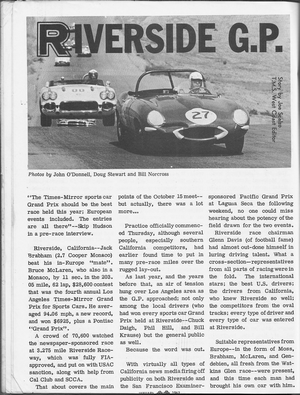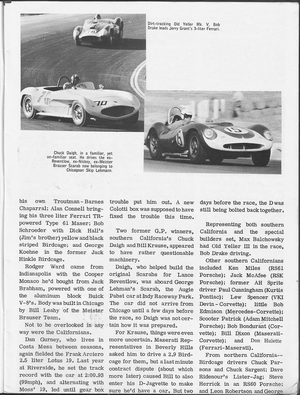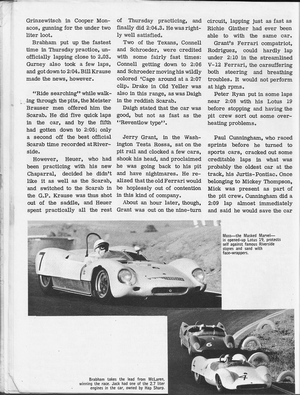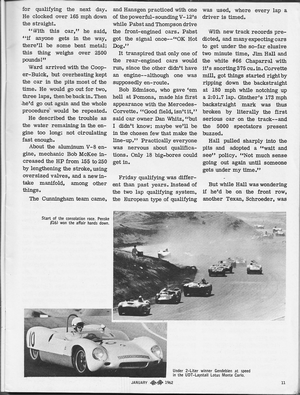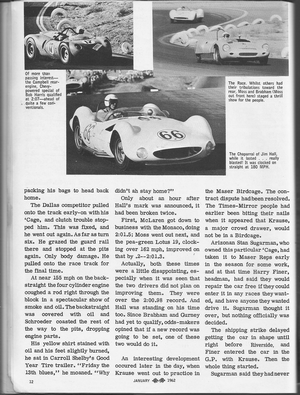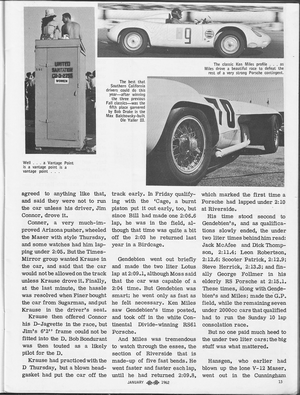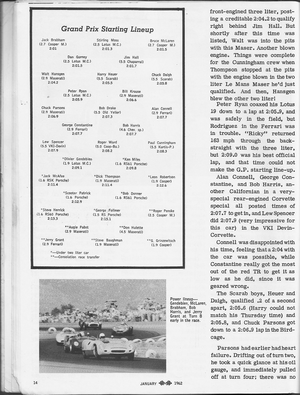|
By accessing or using The Crittenden Automotive Library™/CarsAndRacingStuff.com, you signify your agreement with the Terms of Use on our Legal Information page. Our Privacy Policy is also available there. |

Riverside G.P.
|
|---|
|
|
Riverside G.P.
Joe Scalzo, T.M.S. West Coast Editor
Today's Motor Sports
January 1962
"The Times-Mirror sports car Grand Prix should be the best race held this year; European events included. The entries are all there"--Skip Hudson in a pre-race interview.
Riverside, California--Jack Brabham (2.7 Cooper Monaco) beat his in-Europe "mate". Bruce McLaren, who also in a Monaco, by 11 sec. in the 203.05 mile, 62 lap, $28,600 contest that was the fourth annual Los Angeles Times-Mirror Grand Prix for Sports Cars. He averaged 94.06 mph, a new record, and won $6925, plus a Pontiac "Grand Prix".
A crowd of 70,600 watched the newspaper-sponsored race at 3.275 mile Riverside Raceway, which was fully FIA-approved, and put on with USAC sanction, along with help from Cal Club and SCCA.
That about covers the main points of the October 15 meet--but actually, there was a lot more...
Practice officially commenced Thursday, although several people, especially southern California competitors, had earlier found time to put in many pre-race miles over the rugged lay-out.
As last year, and the years before that, an air of tension hung over Los Angeles area as the G.P. approached; not only among the local drivers (who had won every sports car Grand Prix held at Riverside--Chuck Daigh, Phil Hill, and Bill Krause) but the general public as well.
Because the word was out.
With virtually all types of California news media firing off publicity on both Riverside and the San Francisco Examiner-sponsored Pacific Grand Prix at Laguna Seca the following weekend, no one could miss hearing about the potency of the field drawn for the two events.
Riverside race chairman Glenn Davis (of football fame) had almost out-done himself in luring driving talent. What a cross-section—representatives from all parts of racing were in the fold. The international stars; the best U.S. drivers; the drivers from California, who knew Riverside so well; the competitors from the oval tracks; every type of driver and every type of car was entered at Riverside.
Suitable representatives from Europe--in the form of Moss, Brabham, McLaren, and Gendebien, all fresh from the Watkins Glen race--were present, and this time each man had brought his own car with him. There was thus no question about Europeans driving doggy equipment, as they had in the past Riverside go's.
Really, the Europeans hadn't been the only ones given junk machinery to driven in the past years; oval track men had the same treatment. The first Times-Mirror classic in 1958 found oval tracksters Troy Ruttman, Rodger Ward, Johnnie Parsons, and others with "specials" that would not have qualified for club events.
The next year, attractions Moss and Ward had poor cars; and last year it was Brabham being given a "junker". This year was the first time that everyone was really represented with good cars.
Moss and Gendebien were actually a team--entered by UDT Laystall--with the Britisher in a 2.5 Lotus 19 (the same type of car he led Riverside with last year until he retired) and Gendebien, out for the under-two-liter money, handling a 1.9 version of the rear-engined machine.
It was said that Moss was getting $5000 for appearing at Riverside and Laguna.
To represent Cooper, McLaren and Brabham, appropriately enough, drove Monacos; but the two were in no way on the same "team". Twenty-four year old Bruce--who at Watkins "...drove perhaps the best he ever has", according to his mechanic, Mike Barney--had a Monaco so new it had yet to see formal competition. It was fast. In practice at Silvertone only weeks before Riverside, McLaren had un officially broken the sports car mark with it.
Englishman Peter Berry, who drove all the way to Riverside after Watkins Glen in the 3.8 Jag sedan that Walt Hansgen was to race Saturday at Riverside, owned the Cooper. (Briggs Cunningham bought the Cooper--minus engine--after Laguna Seca.)
Brabham brought his own engine, but borrowed from Hap Sharp the body and chassis of Hap's Cooper Monaco--the definned car that had raced at Elkhart Lake in the "500".
The Secret got out early about McLaren's and Brabham's engines. Both were the "Indianapolis size" Climax mill. There were 2750cc's, not 2500. Brabham had the exact engine he used Memorial Day at Indy, while McLaren had the alternate unit.
The from-out-of-California entrants looked equally formidable.
Briggs Cunningham brought five Maseratis, plus two Cooper Formula Juniors. The Italian cars were: two of the rear-engined V-12's, and front-engined 2.9 liter Type 61, and a couple of two liter Type 60's, one of which was the streamlined, Ferrari-tailed Le Mans car. To drive the Masers--Walt Hansgen, Augie Pabst, and Dick Thompson.
Good friends Roger Penske and Peter Ryan appeared with, respectivly, the red Telar 2.5 Cooper Monaco, and the Mosport-winning 2.5 liter Lotus 19.
Harry Heuer came with a Meister Brauser Scarab and a so-new-it-was-unpainted Troutman-Barnes Chaparral, the latter car using a new Corvette engine built in Chicago by Meister Brauser mecanics. The Chaparral is the new lightweight Corvette-engined car Jim Hall is financing.
George Constantine was with the John Bunch 1960-type three liter Ferrari TR; the car having received scars fore and aft when it was dropped off a plane at the L.A. airport. It was the former Rodriguez machine.
And speaking of Rodriguez, Ricardo, accompanied by his new bride, arrived in Los Angeles Thursday, ready to drive the three liter front-engined Ferrari that brother Pedro raced at Mosport. NART sent the car and Italian mechanic Alberto Pedretti to look after it.
"If Rodriguez takes the lead at the start, he'll be hard to pass", one competitor said, "but it is a 200 mile race."
About Ferrari, there was much talk over whether a works car would appear; rear-engined sports cars in the hands of home town boys World Champ Phil Hill or Ritchie Ginther seemed natural. But apparently because of the Monza tragedy, just like at Watkins Glen, no team Ferraris showed. Ginther was in Europe, but Hill was present, and acted as "Honorary Race Steward".
Ferraris that were in the line-up included Bob Hurt from Maryland in the ex-Sharp three liter TR; popular Riverside driver Skip Hudson in the back-straight record-holding 4.1 four cam; and Washington driver Jerry Grant in Dick Hahn's old 1958 three-liter Testa Rossa.
Because of his Mosport accident, Bob Holbert and his Porsche RS61 missed the G.P., but Colorado's Bob Donner, who brought his Sebring and Elkhart Lake RS61, was present.
There was a "Texas look" at Riverside: Jim Hall having his own Troutman-Barnes Chaparral; Alan Connell bringing his three liter Ferrari TR-powered Type 61 Maser; Bob Schroeder with Dick Hall's (Jim's brother) yellow and black striped Birdcage; and George Koehne in the former Jack Hinkle Birdcage.
Rodger Ward came from Indianapolis with the Cooper Monaco he'd bought from Jack Brabham, powered with one of the aluminum block Buick V-8's. Body was built in Chicago by Bill Leahy of the Meister Brauser Team.
Not to be overlooked in any way were the Californians.
Dan Gurney, who lives in Costa Mesa between seasons, again fielded the Frank Arciero 2.5 liter Lotus 19. Last year at Riverside, he set the track record with the car at 2:00.93 (99mph), and alternating with Moss' 19, led until gear box trouble put him out. A new Colotti box was supposed to have fixed the trouble this time.
Two former G.P. winners, southern California's Chuck Daigh and Bill Krause, appeared to have rather questionable machinery.
Daigh, who helped build the original Scarabs for Lance Reventlow, was aboard George Lehman's Scarab, the Augie Pabst car at Indy Raceway Park. The car did not arrive from Chicago until a few days before the race, so Daigh was not certain how it was prepared.
For Krause, things were even more uncertain. Maserati Representatives in Beverly Hills asked him to drive a 2.9 Birdcage for them, but a last minute contract dispute (about which more later) caused Bill to also enter his D-Jagvette to make sure he'd have a car. But two days before the race, the D was still being bolted back together.
Representing both Southern California and the special builders set, Max Balchowsky had Old Yeller III in the race, Bob Blake driving.
Other southern Californians included Ken Miles (RS61 Porsche); Jack McAfee (RSK Porsche), former AH Sprite driver Paul Cunningham (Kurtis Pontiac); Lew Spencer (VKI Devin-Corvette); little Bob Edmison (Mercedes-Corvette); Scooter Patrick (Adam Mitchell Porsche); Bob Bondurant (Corvette); Bill Dixon (Maserati-Corvette); and Don Hulette (Ferrari-Maserati).
From northern California--Birdcage drivers Chuck Parsons and Chuck Sargent; Dave Ridenhour's Lister-Jag; Steve Herrick in an RS60 Porsche; and Leon Robertson and George Grinzewitsch in Cooper Monacos, gunning for the under two liter loot.
Brabham put up the fastest time in Thursday practice, unofficially lapping close to 2.03. Gurney also took a few laps, and got down to 2:04. Bill Krause made the news, however.
"Ride searching" while walking through the pits, the Meister Brauser men offered him the Scarab. He did five quick laps in the car, and by the fifth had gotten down to 2:05; only a second off the best official Scarab time recorded at Riverside.
However, Heuer, who had been practicing with his new Chaparral, decided he didn't like it as well as the Scarab, and switched to the Scarab in the G.P. Krause was thus shot out of the saddle, and Heuer spent practically all the rest of Thursday practicing, and finally did 2:04.3. He was rightly well satisfied.
Two of the Texans, Connell and Schroeder, were credited with some fairly fast times: Connell getting down to 2:06 and Schroeder moving his wildly colored 'Cage around at a 2:07 clip. Drake in Old Yeller was also in this range, as was Daigh in the reddish Scarab.
Daigh stated that the car was good, but not as fast as the "Reventlow type".
Jerry Grant, in the Washington Testa Rossa, sat on the pit rail and clocked a few cars, shook his head, and proclaimed he was going back to his pit and have nightmares. He realized that the old Ferrari would be hopelessly out of contention in this kind of company.
About an hour later, though, Grant was out on the nine-turn circuit, lapping just as fast as Ritchie Ginther had ever been able to do with the same car.
Grant's Ferrari compatriot, Rodriguez, could hardly lap under 2:10 in the streamlined V-12 Ferrari, the car suffering both steering and breathing troubles. It would not perform at high rpms.
Peter Ryan put in some laps near 2:08 with his Lotus 19 before stopping and having the pit crew sort out some overheating problems.
Paul Cunningham, who raced sprints before he turned to sports cars, cracked out some creditable laps in what was probably the oldest car at the track, his Jurtis-Pontiac. Once belonging to Mickey Thompson, Mick was present as part of the pit crew. Cunningham did a 2:09 lap almost immediately and said he would save the car for qualifying the next day. He clocked over 165 mph down the straight.
"With this car," he said, "if anyone gets in the way, there'll be some bent metal; this thing weighs over 2500 pounds!"
Ward arrived with the Cooper-Buick, but overheating kept the car in the pits most of the time. He would go out for two, three laps, then be back in. Then he'd go out again and the whole procedure would be repeated.
He described the trouble as the water remaining in the engine too long; not circulating fast enough.
About the aluminum V-8 engine, mechanic Bob McKee increased the HP from 155 to 250 by lengthening the stroke, using oversized valves, and a new intake manifold, among other things.
The Cunningham team came, and Hansgen practiced with one of the powerful-sounding V-12's while Pabst and Thompson drive the front-engined cars. Pabst got the signal once--"OK Hot Dog."
It transpired that only one of the rear-engined cars would run, since the other didn't have an engine--although one was supposedly en-route.
Bob Edmison, who gave 'em hell at Pomona, made his first appearance with the Mercedes-Corvette. "Good field, isn't it," said car owner Dan Whitz, "but I didn't know; maybe we'll be in the chosen few that make the line-up." Practically everyone was nervous about qualifications. Only 18 big-bores could get in.
Friday qualifying was different than past years. Instead of the two lap qualifying system, the European type of qualifying was used, where every lap a driver is timed.
With new track records predicted, and many expecting cars to get under the so-far elusive two minute time, Jim Hall and the white #66 Chaparral with it's snorting 375 cu. in. Corvette mill, got things started right by ripping down the backstraight at 180 mph while notching up a 2:01.7 lap. Ginther's 173 mph backstraight mark was thus broken by literally the first serious car on the track--and the 5000 spectators present buzzed.
Hall pulled sharply into the pits and adopted a "wait and see" policy. "Not much sense going out again until someone gets under my time."
But while Hall was wondering if he'd be on the front row, another Texan, Schroeder, was packing his bags to head back home.
The Dallas competitor pulled into the track early-on with his 'Cage, and clutch trouble stopped him. This was fixed, and he went out again. As far as turn six. He grazed the guard rail there and stopped at the pits again. Only body damage, he pulled onto the race track for the final time.
At near 155 mph on the backstraight the four cylinder engine coughed a rod right through the block in a spectacular show of smoke and oil. The backstraight was covered with oil and Schroeder coasted the rest of the way to the pits, dropping engine parts.
His yellow shirt stained with oil and his feet slightly burned, he sat in Carroll Shelby's Good Year Tire trailer. "Friday the 13th blues," he moaned. "Why didn't ah stay home?"
Only about an hour after Hall's mark was announced, it had been broken twice.
First, McLaren got down to business with the Monaco, doing 2:01.5; Moss went out next, and the pea-green Lotus 19, clocking over 162 mph, improved on that by .2--2:01.3.
Actually, both these times were a little disappointing, especially when it was seen that the two drivers did not plan on improving them. They were over the 2:00.98 record. And Hall was standing on his time too. Since Brabham and Gurney had yet to qualify, odds-makers opined that if a new record was going to be set, one of these two would do it.
An interesting development occurred later in the day, when Krause went out to practice in the Maser Birdcage. The contract dispute had been resolved. The Times-Mirror people had earlier been biting their nails when it appeared that Krause, a major crowd drawer, would not be in a Birdcage.
Arizonan Stan Sugarman, who owned this particular 'Cage, had taken it to Maser reps early in the season for some work, and at that time Harry Finer, headman, had said they would repair the car free if they could enter it in any races they wanted, and have anyone they wanted drive it. Sugarman thought it over, but nothing officially was decided.
The shipping strike delayed getting the car in shape until right before Riverside, and Finer entered the car in the G.P. with Krause. Then the whole thing started.
Sugarman said they had never agreed to anything like that, and said they were not to run the car unless his driver, Jim Connor, drove it.
Connor, a very much-improved Arizona pusher, wheeled the Maser with style Thursday, and some watches had him lapping under 2:05. But the Times-Mirror group wanted Krause in the car, and said that the car would not be allowed on the track unless Krause drove it. Finally, at the last minute, the hassle was resolved when Finer bought the car from Sugarman, and put Krause in the driver's seat.
Krause then offered Connor his D-Jagvette in the race, but Jim's 6'2" frame could not be fitted into the D. Bob Bondurant was then touted as a likely pilot for the D.
Krause had practiced with the D Thursday, but a blown headgasket had put the car off the track early. In Friday qualifying with the 'Cage, a burnt piston put it out early, too, but since Bill had made one 2:06.6 lap, he was in the field, although that time was quite a bit off the 2:03 he returned last year in a Birdcage.
Gendebien went out briefly and made the two liter Lotus lap at 2:09.1, although Moss said that the car was capable of a 2:04 time. But Gendebien was smart; he went only as fast as he felt necessary. Ken Miles saw Gendebien's time posted, and took off in the white Continental Divide-winning RS61 Porsche.
And Miles was tremendous to watch through the esses, the section of Riverside that is made-up of five fast bends. He went faster and faster each lap, until he had returned 2:09.8, which marked the first time a Porsche had lapped under 2:10 at Riverside.
His time stood second to Gendebien's, and as qualifications slowly ended, the under two liter times behind him read: Jack McAfee and Dick Thompson, 2:11.4; Leon Robertson, 2:12.6; Scooter Patrick, 2:12.9; Steve Herrick, 2:13.3; and finally George Follmer in his elderly RS Porsche at 2:15.1. These times, along with Gendebien's and Miles; made the G.P. field, while the remaining seven under 2000cc cars that qualified had to run the Sunday 10 lap consolation race.
But no one paid much heed to the under two liter cars; the big stuff was what mattered.
Hansgen, who earlier had blown up the lone V-12 Maser, went out in the Cunningham front-engined three liter, posting a creditable 2:04.2 to qualify right behind Jim Hall. But shortly after this time was listed, Walt was into the pits with this Maser. Another blown engine. Things were complete for the Cunningham crew when Thompson stopped at the pits with the engine blown in the two liter Le Mans Maser he'd just qualified. And then, Hansgen blew the other two liter!
Peter Ryan coaxed his Lotus 19 down to a lap at 2:05.9, and was safely in the field, but Rodriguez in the Ferrari was in trouble. "Ricky" returned 163 mph through the backstraight with the three liter, but 2:09.0 was his best official lap, and that time could not make the G.P. starting line-up.
Alan Connell, George Constantine, and Bob Harris, another Californian in a very-special rear-engined Corvette special all posted times of 2:07.7 to get in, and Lew Spencer did 2:07.9 (very impressive for this car) in the VKI Devin-Corvette.
Connell was disappointed with his time, feeling that a 2:04 with the car was possible, while Constantine really got the most out of the red TR to get it as low as he did, since it was geared wrong.
The Scarab boys, Heuer and Daigh, qualified .2 second apart, 2:05.6 (Harry could not match his Thursday time) and 2:05.8, and Chuck Parsons got down to a 2:06.9 lap in the Birdcage.
Parsons had earlier had heart failure. Drifting out of turn two, he took a quick glance at his oil gauge, and immediately pulled off at turn four; there was no pressure at all! Grant motored by in the Ferrari, stopped, asked Parsons if he wanted a ride back to the pits, and went on. Back at the pits, Parsons was quite nervous as Jock Ross checked the oil level and found it fine. What was the trouble? (Of all things) A faulty gauge! Just a faulty gauge, and Parsons started breathing again.
Bob Drake talked Old Yeller III into lapping at 2:07.3, which was most impressive, considering that Yeller was not supposed to be a race car (Balchowsky had originally built it as a street machine).
(continued next month)

















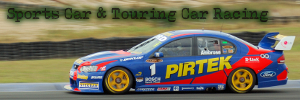 Topics: Los Angeles Times presents the Grand Prix for Sports Cars
Topics: Los Angeles Times presents the Grand Prix for Sports Cars
